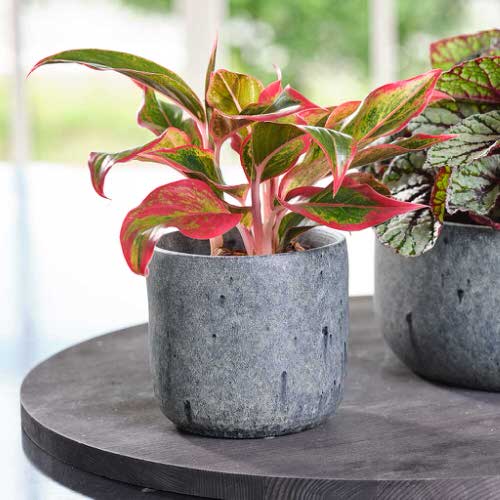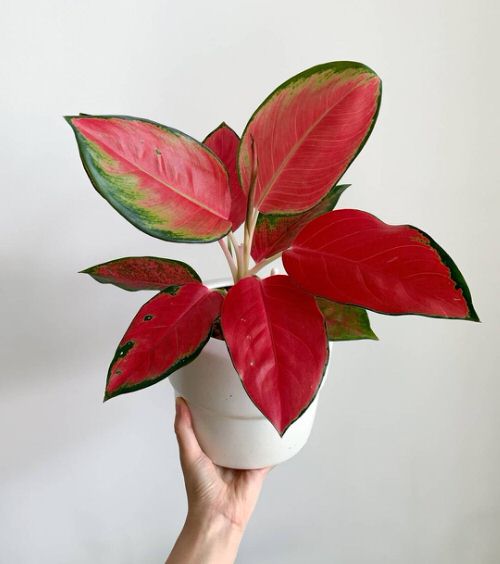Wondering how to keep your aglaonema vivid and new as you buy from the plant store? Follow these Aglaonema Care Tips to Keep it Red and Shiny all year long!

Red Aglaonema is one of the best houseplants you can grow for its vivid red and glossy foliage. To make sure it stays stunning all the time, we have some useful Aglaonema Care Tips to Keep it Red and Shiny!
Check out our article on growing Aglaonema indoors here
Aglaonema Care Tips to Keep it Red and Shiny
1. The Power of Light

Here’s a thing with aglaonemas: too much direct sunlight–colors will fade, too little–colors will fade. Aglaonemas don’t like direct sun exposure, so avoid that. Commercial growers maintain 75 to 90 percent shade or 1250 to 3000-foot candles of light. However, this low light houseplant can tolerate a light level as minimum as 25-foot candles.
To maintain the deep red hue of the leaves, select a spot that receives bright indirect daylight. If growing outdoors, select a shady place in your garden.
2. Wipe the Foliage
The best way to ensure the glossy red foliage looks stunning all the time is to wipe it clean with a moist, soft cloth once in 5-7 days. This will keep the dust off the leaves, making the plant look eye-catching, always with deep hues! Not just that, doing this will also improve the plant’s ability to photosynthesize.
3. Copper Deficiency
Aglaonemas are prone to copper deficiency, and if you notice distorted and dwarfed leaves with discoloration, it may be the symptom of copper deficiency. To prevent this, you can use a fertilizer that contains micronutrients like copper.
4. Water Carefully
If your aglaonema leaves are fading and turning yellow, it may be due to improper watering. Most commonly, the case of overwatering. This plant prefers slightly moist soil, but it should never be overly wet for a long time. Watering the plant too frequently will make it lose the sheen and color of the leaves. Let the topsoil dry out a bit before the next watering but never let the plant dry out completely.
5. Select the Right Variety

Well, there’s no rocket science behind this! To enjoy the vivid color, grow a variety that offers the reddest leaves! Go for Red Emperor, Red Zircon, Siam Aglaonema, Ultra Pink, Red Emerald, and Super Red Star. Not just that, you can discover more red aglaonema cultivars here!
6. Keep an Eye on Temperature
Do not expose the plant to an air temperature below 55 F (12.7 C), as it can cause chilling injury. The best temperature is between 70-85 F (21-30 C) to enjoy the best appearance of an aglaonema plant. Similarly, excess heat and too much light exposure are also responsible for the faded leaves and washed-out appearance of the plant.
7. Use the Right Pot
Aglaonema loves to be slightly root-bound, so do not transfer them into a big container. Always go for one size bigger plant when re-potting.
Here’s everything you need to know about growing Monstera Peru
8. Feed Them Right

When it comes to fertilizers, Aglaonemas are not demanding at all. You can promote the growth and red color of the foliage by feeding the plant with a 3-1-2 NPK ratio, or apply your regular balanced liquid fertilizer like 10-10-10 once in a month.
9. Epsom Salt
Use Epsom salt occasionally as fertilizer for your aglaonema plant. Epsom salt contains magnesium and sulfur, and applying this will boost the absorption of essential nutrients required by the plant to grow well and produce a deep red color.
It also prevents leaf curling and yellow foliage that happens due to a lack of magnesium.
10. Cut the Flowers
And last but not least, if you ever notice blooms on your aglaonema (Chinese evergreen) plant, it is better to cut them to improve the plant’s longevity, color, and fullness. You should also remove dead and faded leaves from time to time to enhance the appearance of your houseplant.


